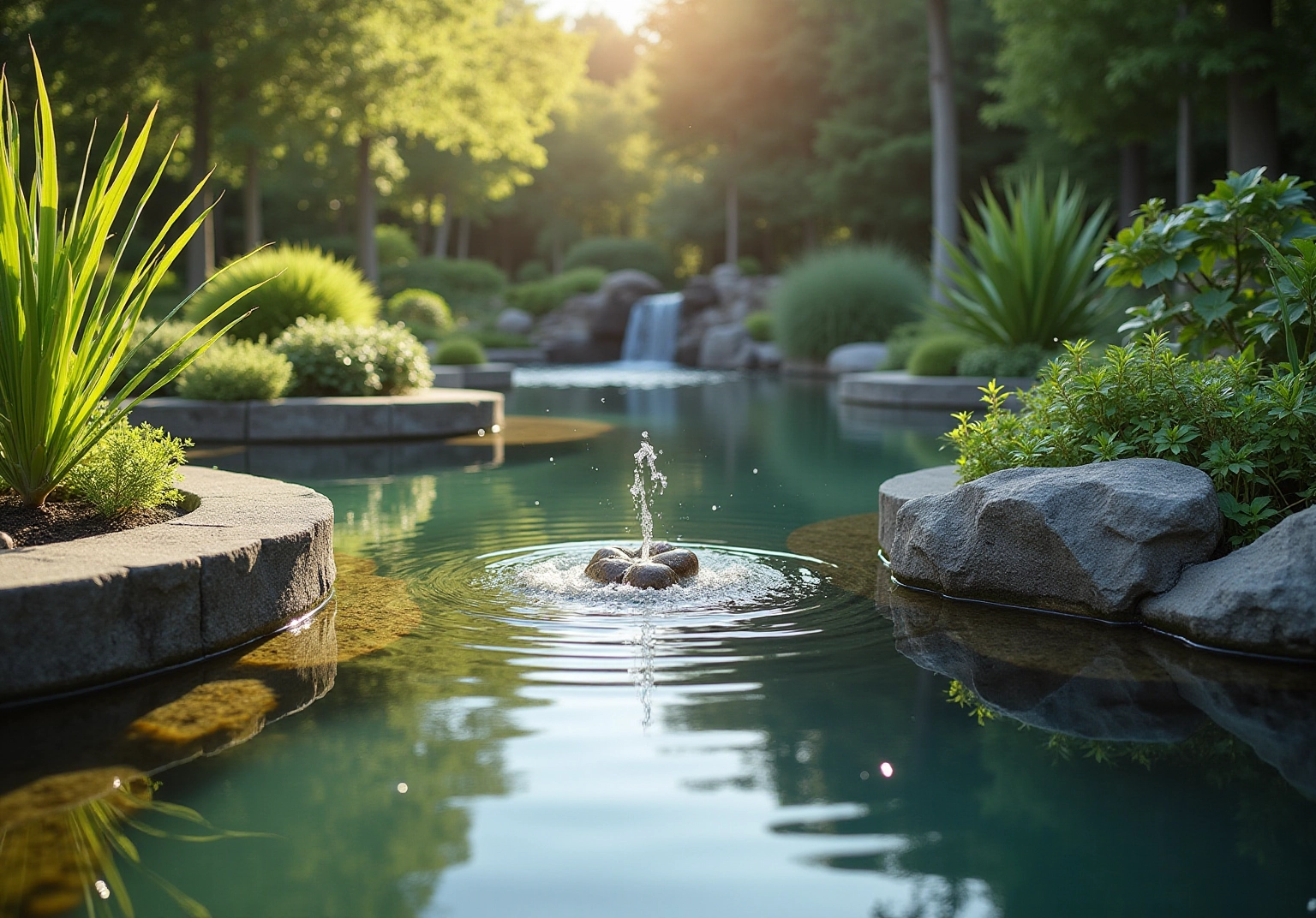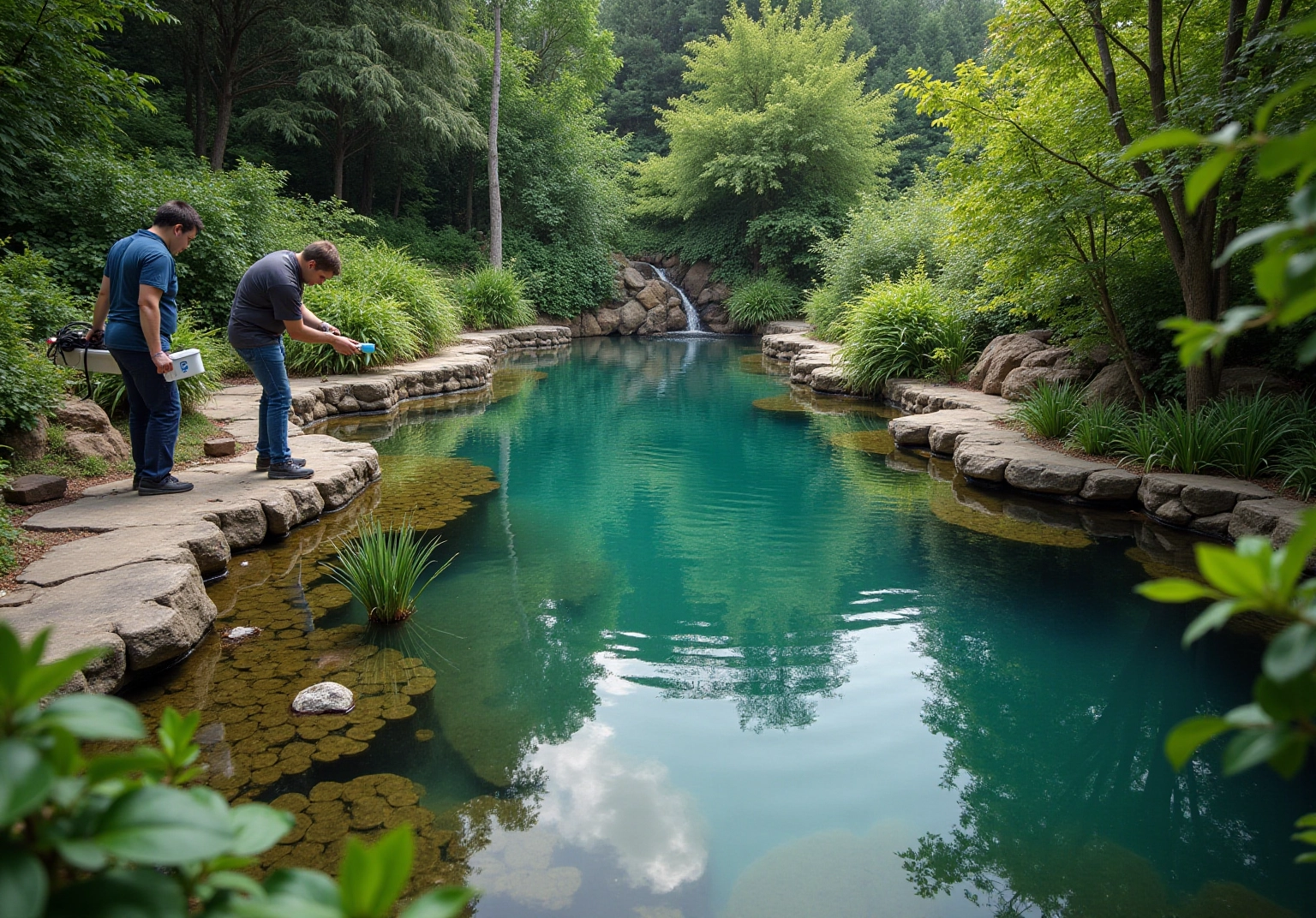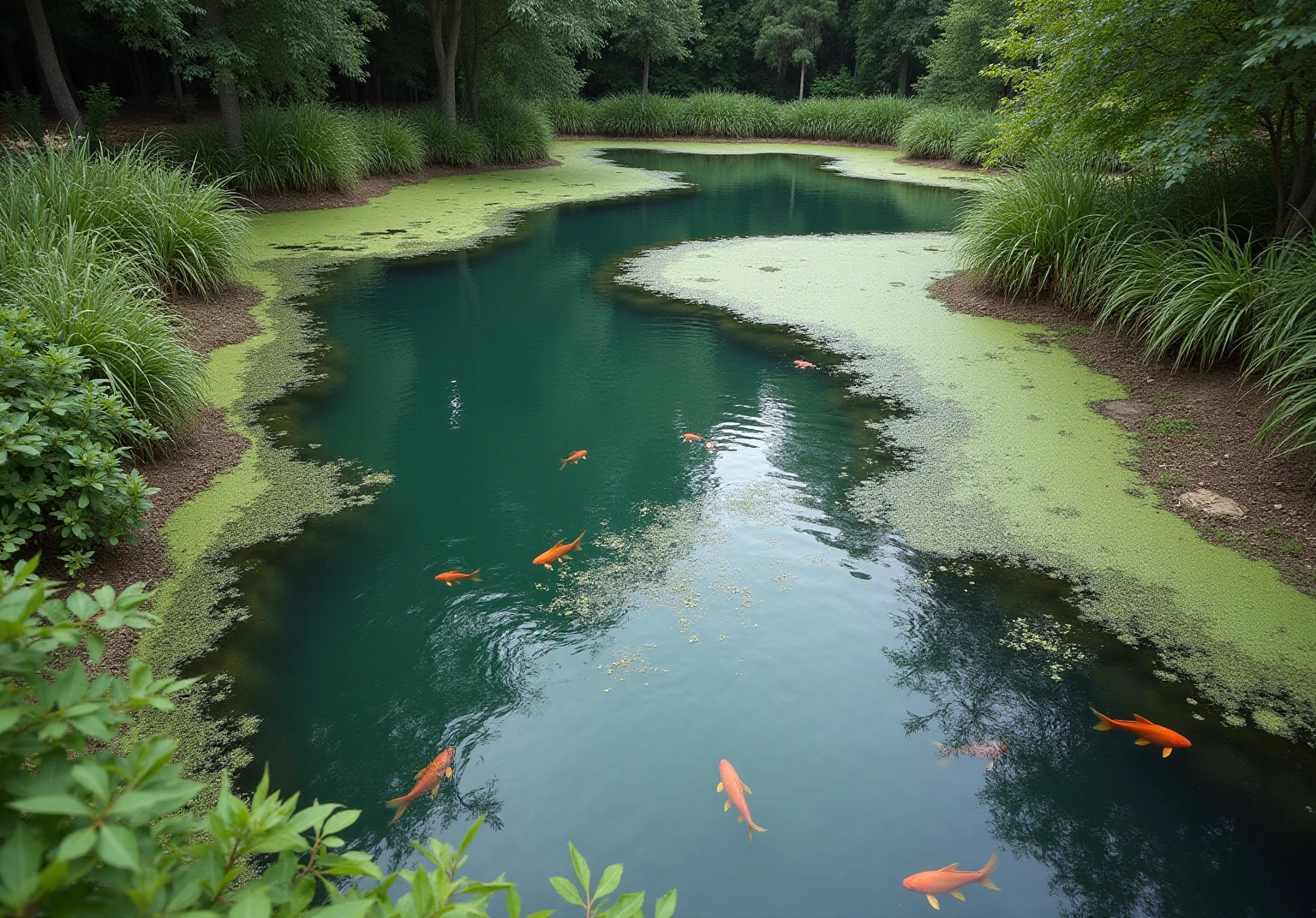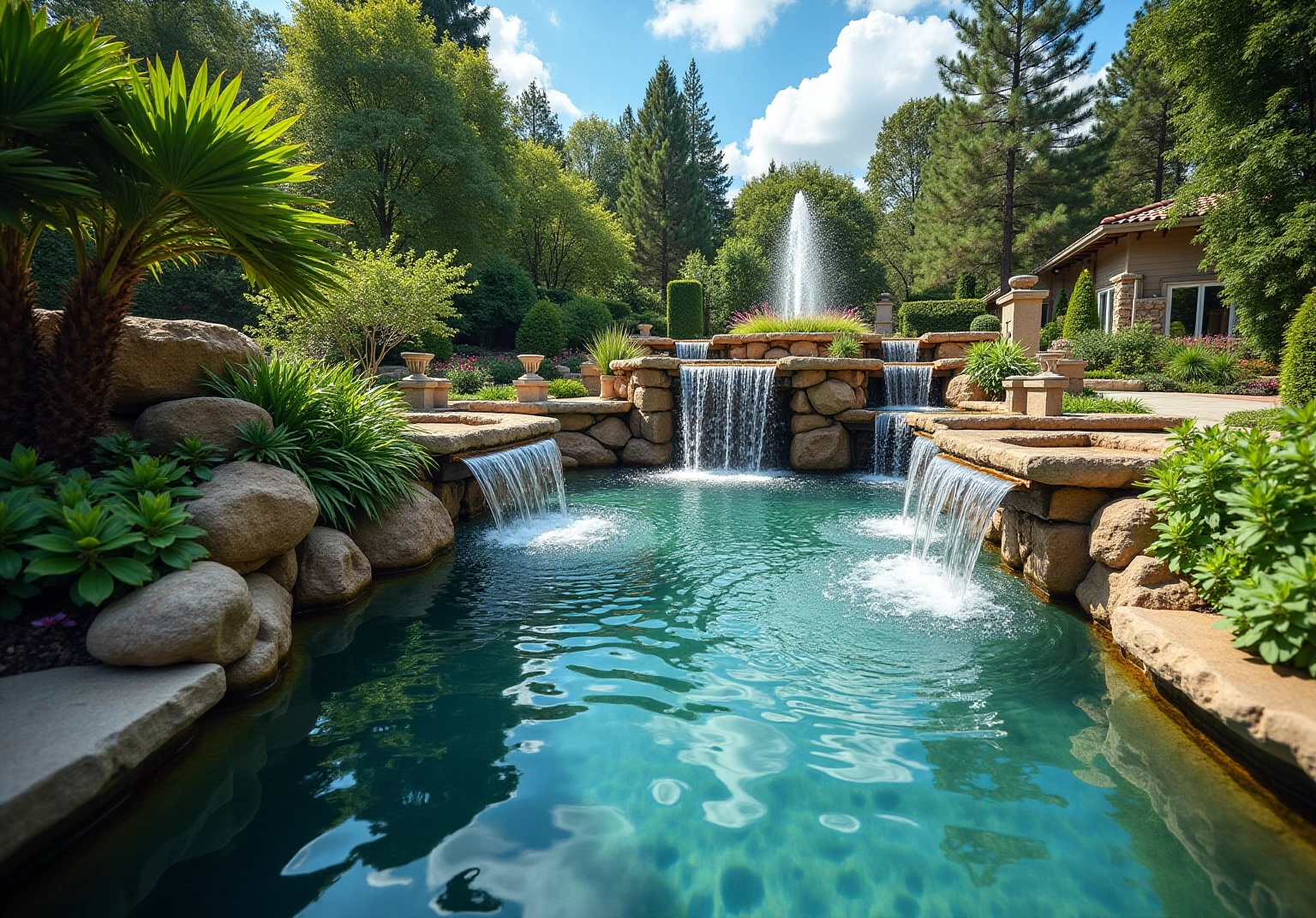Overview
Maintaining ponds at luxury homes involves essential steps such as:
- Routine cleaning
- Water quality testing
- Plant management
- Aeration
- Fish care
These practices significantly contribute to both the health and aesthetic appeal of the water feature. Consistent maintenance not only prevents issues like algae blooms and murky water but also enhances property value and the overall enjoyment of outdoor spaces. This makes pond maintenance a worthwhile investment for homeowners, reflecting a commitment to quality and excellence.
Introduction
In the realm of luxury homeownership, a pristine pond can significantly enhance a property’s aesthetic and value, creating a serene oasis that invites relaxation and enjoyment. However, the beauty of these aquatic features relies on consistent and effective maintenance, which is essential not only for preserving water quality but also for protecting the investment made in such elegant landscapes.
Homeowners often encounter challenges in ensuring their ponds remain a vibrant centerpiece. By understanding common pitfalls, they can navigate the complexities of maintaining an inviting aquatic environment.
Understand the Importance of Pond Maintenance
For several reasons, the maintenance of ponds is essential for luxury homeowners. It plays a crucial role in maintaining water quality, which is vital for the health of both fish and aquatic plants. Regular maintenance of ponds helps prevent the accumulation of debris and algae, which can lead to unpleasant odors and an unattractive appearance. A well-maintained water feature not only enhances the overall aesthetic appeal of your property but also creates a more inviting atmosphere for family and guests. Furthermore, consistent maintenance of ponds can prevent costly repairs in the future, safeguarding your investment and ensuring that the water feature remains both functional and appealing.
As highlighted by satisfied customers of Grow Landscapes, who have experienced exceptional service in designing lavish outdoor spaces, properties with pristine water features often see an increase in value. Prospective buyers are drawn to well-maintained outdoor settings, which can significantly enhance marketability. By following a consistent maintenance plan, homeowners can fully appreciate the many benefits of the maintenance of ponds, from improved aesthetics to increased property value. This dedication to quality not only enriches the homeowner’s experience but also reinforces the importance of investing in regular maintenance for lasting beauty and functionality.

Follow Essential Steps for Effective Pond Maintenance
To maintain your pond effectively, follow these essential steps:
-
Routine Cleaning: Regularly remove debris such as leaves, twigs, and algae from the pond surface and edges. This practice prevents organic matter from decomposing in the water, which can lead to poor quality. Consistent cleanings are crucial for the maintenance of ponds, with a deep cleaning recommended at least once a year to uphold clarity and health.
-
Fluid Quality Testing: Analyze the chemistry of the water weekly for pH, ammonia, and nitrate levels. Maintaining optimal pH levels between 6.5 and 9.5 is essential for aquatic life, as elevated pH can increase ammonia toxicity. Utilize a reliable testing kit to ensure the environment is suitable for fish and plants, as adverse conditions can heighten disease susceptibility among fish. As specialists observe, frequent water assessment is essential for the maintenance of ponds and ensuring a healthy aquatic environment.
-
Plant Management: Trim overgrown aquatic plants and remove any dead vegetation. This practice helps maintain a balanced ecosystem and prevents overcrowding, which can lead to nutrient overload and algae blooms. Incorporating floating plants can also enhance oxygen levels and reduce sunlight penetration, further controlling algae growth.
-
Aeration: Ensure proper aeration of the water body to promote oxygen circulation. High-volume aerators or ornamental fountains not only enhance the visual appeal of the aquatic environment but also improve water quality by increasing dissolved oxygen levels, which are vital for fish health.
-
Fish Care: Monitor the fish population and overall health. Avoid overfeeding, as excess food can pollute the water and lead to imbalances. Regularly check for signs of disease or distress among the fish, as maintaining optimal dissolved oxygen levels above 5 mg/L is crucial for their well-being.

Identify and Resolve Common Pond Maintenance Issues
Common pond maintenance issues include:
- Algae Blooms: Excess nutrients, primarily from overfeeding fish and runoff, can lead to harmful algal blooms (HABs). To mitigate this, it is essential to limit nutrient input by avoiding overfeeding and incorporating aquatic plants that naturally absorb excess nutrients. Research indicates that 66% of observed sampling occurrences in urban water bodies surpassed World Health Organization standards for microcystin concentrations, highlighting the importance of proactive management.
- Murky Water: This issue often arises from sediment buildup or inadequate filtration. The maintenance of ponds through frequent cleaning is crucial, and installing a high-quality filtration system can significantly enhance clarity. Utilizing products like smartpond Water Clarifier can assist in condensing floating particles, thereby improving overall water quality.
- Fish Health Problems: Regular monitoring of fish is vital. Look for signs of illness, such as unusual swimming patterns or discoloration. Isolate any ill fish and consult a water specialist to address potential health concerns promptly. Maintaining a proper fish-to-water ratio—one gallon of water for every inch of adult fish—can prevent overcrowding and related health issues.
- Invasive Plant Species: These species can disrupt the water body’s ecosystem by outcompeting native plants. Regular inspections are necessary for the maintenance of ponds to identify and manually remove invasive species, ensuring a balanced environment. The presence of plant buffer zones can also help mitigate the severity of harmful blooms.
- Structural Issues: Inspect the water body for leaks or erosion around the edges. Timely identification of structural damage is crucial; seek a specialist for evaluation and repairs to support the maintenance of ponds and uphold the integrity of the water body. Consistent maintenance of ponds not only preserves the aesthetic appeal of luxury properties but also enhances the overall health of the aquatic ecosystem.

Conduct Regular Inspections and Monitoring
Routine evaluations are essential for the maintenance of ponds and for preserving the well-being and appearance of upscale aquatic environments, particularly those enhanced by beautiful features such as fountains and waterfalls from Grow Landscapes. Here are essential steps to ensure optimal pond conditions:
- Visual Checks: Conduct weekly inspections to monitor for visible changes, including fluctuations in liquid levels, algae growth, and debris accumulation. Timely identification of these issues can avert larger complications in the future, ensuring that the maintenance of ponds allows your peaceful aquatic features to remain a highlight of calmness in your outdoor area.
- H2O Condition Monitoring: Alongside weekly visual inspections, carry out thorough assessments of the liquid condition on a monthly basis. This should include testing for dissolved oxygen levels and nutrient concentrations. Frequent monitoring is crucial for the maintenance of ponds, as research indicates that they can lose several inches of liquid daily to evaporation, especially in summer, making consistent checks necessary for preserving quality and the health of aquatic life.
- Equipment Functionality: Ensure that all equipment, such as pumps, filters, and aerators, is functioning correctly. Regular upkeep, including the maintenance of ponds, is essential to maintain optimal conditions. Clean and efficient equipment helps prevent stagnation, which can attract pests and harm aquatic life, thereby preserving the beauty of your luxurious water features.
- Seasonal Adjustments: Tailor your maintenance routine to the changing seasons. For example, in autumn, it’s essential to clear leaves and prepare the water feature for winter. This involves ensuring that fish are secure and that the body of water is shielded from freezing conditions, which can harm aquatic ecosystems. Additionally, implement proactive vegetation management strategies to prevent mosquito breeding, which can be exacerbated by overgrowth, ensuring your outdoor space remains inviting.
- Documentation: Maintain a detailed log of inspections, liquid condition results, and any actions taken. This documentation assists in monitoring patterns over time and guides future maintenance of ponds choices, ensuring that the water body remains a beautiful and functional aspect of your property.
- Contemporary Monitoring Tools: Consider utilizing contemporary sampling kits fitted with advanced sensors for swift evaluations of liquid parameters. These tools can streamline the monitoring process and enhance the efficiency of your inspections, allowing you to focus on enjoying your luxurious outdoor space.
- Community Engagement: Engage with local communities in mosquito control education to foster shared responsibility and proactive prevention measures. This collaborative approach can greatly improve the efficiency of your water body maintenance efforts.
By implementing these practices, homeowners can significantly enhance the longevity and health of their luxury ponds through the maintenance of ponds, creating serene outdoor spaces that reflect their commitment to quality and aesthetics, complemented by the exquisite water features provided by Grow Landscapes.

Conclusion
Maintaining a pond at a luxury home transcends mere chore; it stands as a significant investment in beauty, tranquility, and property value. Through diligent upkeep, homeowners can ensure their aquatic features remain vibrant and inviting, enhancing the overall aesthetic appeal of their property while safeguarding their investment. A well-maintained pond serves as a serene oasis, contributing to a welcoming atmosphere for family and guests alike.
Key steps to effective pond maintenance encompass:
- Routine cleaning
- Water quality testing
- Plant management
- Aeration
- Diligent fish care
Addressing common issues such as:
- Algae blooms
- Murky water
- Invasive species
is crucial for preserving the health and beauty of the pond. Regular inspections and monitoring further ensure that any potential problems are identified and resolved promptly, allowing homeowners to enjoy their outdoor spaces without concern.
Ultimately, the significance of maintaining ponds in luxury homes extends beyond aesthetics. It fosters a harmonious ecosystem, enhances property value, and cultivates a peaceful retreat that can be cherished for years to come. By committing to a comprehensive maintenance plan, homeowners not only enrich their living environment but also set a standard for excellence in outdoor living. Investing in the upkeep of these water features is an investment in a lifestyle marked by elegance and tranquility.
Frequently Asked Questions
Why is pond maintenance important for luxury homeowners?
Pond maintenance is essential for luxury homeowners as it helps maintain water quality, which is vital for the health of fish and aquatic plants. It also prevents the accumulation of debris and algae, leading to a more attractive appearance.
What are the benefits of regular pond maintenance?
Regular pond maintenance enhances the aesthetic appeal of the property, creates a more inviting atmosphere, prevents unpleasant odors, and avoids costly repairs in the future.
How does pond maintenance affect property value?
Properties with well-maintained water features often see an increase in value, as prospective buyers are drawn to attractive outdoor settings, enhancing marketability.
What can homeowners do to appreciate the benefits of pond maintenance?
Homeowners can follow a consistent maintenance plan to fully appreciate benefits such as improved aesthetics, increased property value, and lasting beauty and functionality of their ponds.



